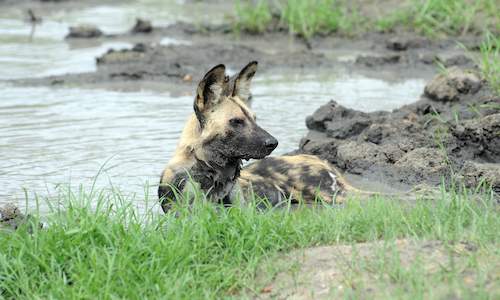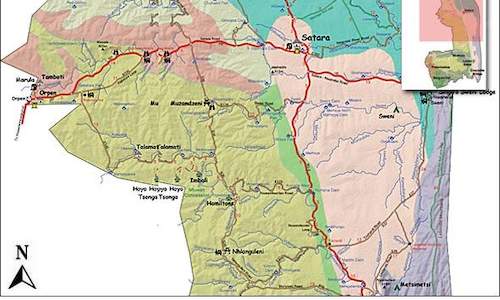The Central Kruger Park Region
Images of a Great African Park
The sweet grasses that grow on fertile soils formed on shale and volcanic basalt, and an abundance of excellent browsing trees, sustain the largest impala, buffalo, giraffe, kudu, wildebeest, zebra, waterbuck and sable populations in the Park.Although this region makes up only
30 per cent of the park's surface area, it accounts for 40 per cent of its total biomass, supports nearly half of the Park's lion and sizeable numbers of leopard, hyaena and cheetah.
A belt of granite in the west of this region ends roughly in line with the main road from Skukuza to Olifants camps, bordering an extensive intrusion of basalt that extends
eastward to the Lebombo Mountains. This latter region produces clay soils that are rich in the elements required by plants. The savanna here is dominated by marula (Sclerocarya birrea) and knobthorn (Acacia nigrescens) trees scattered across sweet veld, and browsers find these species particularly palatable.
Apart from their edible fruit, which is eaten by many animals, elephants eat the leaves and
bark of the marula tree, and the larvae of eight species of butterfly are known to feed on its foliage. Giraffe and kudu are especially partial to knobthorns, but avoid competition for the same food source by feeding at different heights. About 30 per cent of the giraffe's diet is made up of knobthorn leaves, and in some parts of the Central Region giraffe densities are as high as one animal per two square kilometres.
Apart from elephants, which are now widely distributed throughout the Central Region of Kruger National Park, the
black rhino is an important browser that is seldom seen. Between 1980 and 1989 groups of black rhino from KwaZulu-Natal were released at Kumana, Leeupan and along the Sweni River.
Although it is difficult to count these retiring animals, it would appear as if a stable population is now present in the Central Region.The basalt plains support a wealth of birds, but several species exhibit a particular preference for this habitat. These include pallid harrier,
secretary bird, ostrich, kori bustard, redbacked mannikin, Swainson's francolin, chestnutbacked finchlark, doublebanded sandgrouse and wattled starling.
Fences and Foot-and-Mouth
The inclusion of the
game-rich Central Region was the most difficult part of the negotiations that led to the proclamation of the Kruger National Park in 1926. All the land between the Sabie and Olifants rivers had previously been surveyed into farms, although conditions were not conducive for settled agriculture at the time.
Most of the land around Satara belonged to the state and could be incorporated, but to the north and south 33 privately-owned and
49 company-owned farms, mostly the property of the Transvaal Consolidated Land Company, had to be expropriated or exchanged for land elsewhere.
The Kruger Park's uneven western boundary was therefore decided more by the need to
limit the number of farms the government needed to purchase, than it was by any ecological consideration.
Between 1935 and 1944, Eileen Orpen bought seven farms covering 24 529 hectares to extend the western boundary, but even such a generous gift did not include enough land to adequately
support the Park's migratory herds. When a fence was erected in 1960 by the state veterinary authority to prevent the spread of foot-and-mouth disease to cattle from game, game herds were cut off from their favoured summer grazing lands.
Between 1969 and 1977 the wildebeest populations (three herds) in the central district dropped by 68 per cent. A wet cycle made it worse by causing above-average growth of grass;
wildebeest prefer to graze shorter grass, and lion can stalk them with ease through long grass.
Park managers incorrectly blamed lion and wet cycles for this drastic decline in numbers, but the
fence turned out to be the main culprit. More thorough investigation revealed that the western herd, which used to migrate from the Sabie area in winter to the Timbavati area northwest of Orpen, had suffered the most, plummeting by 90 per cent.
The wildebeest subsequently responded favourably to a dry cycle, and the
fence was removed in 1994, but the case study was evidence of the complexity of the ecosystem and the knock-on effect that a single action can have on population dynamics. Just erecting a fence can play havoc with a system by disrupting migratory patterns, as has been the case all over Africa - and especially in Botswana.
Five seasonal rivers meander across the Central Region and, as wildlife is abundant, during intense dry cycles water supplies are often depleted. The Timbavati River was perennial in the early days, but forestry, agriculture and habitat degradation beyond the Park's boundaries drastically reduced its flow. Despite these factors, large pools still occurred in the river and for a time two were deep enough to support herds of hippos. But runoff from
overgrazed lands upstream silted up the pools in the mid-1960s, and the river ceased to be a reliable source of water.
This pattern of pools silting up and rivers becoming more erratic was well documented by Park rangers, and as a result many
man-made dams and water holes were established in the Central Region. Some of these water points complicated an already complex situation by concentrating game herds in areas that were traditionally utilised only during summer.
Many of the water holes and
dams have become popular tourist attractions, but water holes established far from riverbeds, and in areas that would have been waterless in winter, were incorrectly placed. Some of the most important dams in the Central Region were built in the Park's early, formative years. These include Kumana (1935), Mazithi (1936), Orpen (1945), Mlondozi (1951), Gudzani (1952), Ngwenyeni and Vutomi (1956).
Predator Paradise
The
concentration of predators, especially lions, in the Central Region ensures that it remains a popular tourist destination. As a result there are many camps in the region. Situated in the centre of the region, Satara is the second largest camp in Kruger, and there are also two smaller rest camps, the charming Tamboti Tented Camp, a camping and caravan camp, two private camps and two bushveld camps.
No fewer than 60 lion prides occupy home ranges in the Central Region, with an average pride size of 12 lions, and within a 20 kilometre radius of Satara 22, lion prides have been counted. An
adult lion requires about nine zebra per year, or the equivalent prey weighing 1 500 kilograms, and lion kill on average every three to four days.
The size of a
lion pride's territory ranges from 20 to about 400 square kilometres, depending on food availability, but in the Central Region territories are generally not much larger than 80 square kilometres. Studies have shown that lion are opportunistic hunters and will alter the prey they select in times of drought.
A study of 257
Lion in the Central Region found that giraffe, wildebeest and zebra provided 81 per cent of all food consumed, but accounted for only half of kills made due to the large size of these animals. In times of drought, lion preyed heavily on buffalo and less so on zebra and wildebeest, but zebra normally comprise one-seventh of lion kills.
Mostly zebra foals are killed by lions, but in the case of wildebeest, animals of all ages are caught. In response to lion attacks, the 12 000 strong zebra in the region give birth to about 4 000 foals each year and are able to withstand predation, but do not thrive during wet cycles as they require grass of a medium length.
Zebra and Wildebeest, therefore, are two species that do best when rainfall is below normal.
The high density of lions in the region, estimated at about 13 per 100 square kilometres, has major repercussions for two of Kruger's rare predators. Only 60 cheetah have been observed over the entire region, although their favourite prey is abundant and the open
savannas provide ideal opportunities for hunting. A census found that adult cheetah also outnumber young animals, and the ratio of females without cubs to mothers with cubs was higher when compared to other regions, which is indicative of a population that is sparsely distributed.
The overall density of
Cheetah in the Central Region is only half that of the Southern Region, which contains less ideal habitat. Where new parks have been established elsewhere in South Africa, and the full component of predators has been re-introduced, many of the released cheetahs have fallen victim to lion attacks.
The density of lion also negatively affects the distribution of
the endangered Wild Dog. Wild dog are highly endangered and occur in only 13 African countries. With a total population numbering less than 5 000, only six populations including Kruger's contain more than 100 dogs. However, more than 80 per cent of wild dog in the Park are younger than four years of age, and very few live to the age of seven years, which indicates that disease and predation are exacting a heavy toll.
A comprehensive survey located
only six packs throughout the Central Region, and almost all of these packs were found on the sandy granite soils that occur in a south to north band stretching from the Sabie River northward along the Hlanguleni road to the Olifants River.
On the fertile eastern plains, where wildlife is plentiful, wild dog are seldom seen. Is this because wild dog prefer sandy conditions to clay soil? One explanation suggested that, as
Wild Dog prey primarily on Impala in Kruger National Park, South Africa. They are concentrated in red bushwillow woodland because impala are common in this vegetation type.
This is unlikely, however, as impala reach their
highest densities in acacia thickets near water. Further investigation found that lion show a marked preference for marula savanna, which is widespread on the eastern plains, and wild dog were most common in mountainous country and sour bushveld.
As lion account for at least one third of
Wild Dog pup deaths, wild dog actively avoid areas where lion are common, even when their favourite prey is plentiful in these parts, and will move their puppies to new dens to avoid predation.
Although cheetah and wild dog do not thrive where lion are numerous, spotted hyaena are able to hold their own. One estimate concluded that there were at least 1 200
Spotted Hyaena in the Central Region, an even larger population than that of their major competitor. In November, when the impala give birth, many hyaena feed exclusively on young impala.
Hyaena
clans are strongly territorial and show evidence of a robust female-dominated hierarchy. In the Central Region they do not attack large mammals, as is the case in East Africa, and are able to survive adequately by preying on small animals and scavenging the remains of lion kills.

The central grasslands have the highest lion population in Kruger. That's because of the availability of prey. The nutritious grasses suppor...
more
This Kruger Park Map of the Central Grasslands region around Satara will help you plan your game drive safari through the Grasslands...
more
